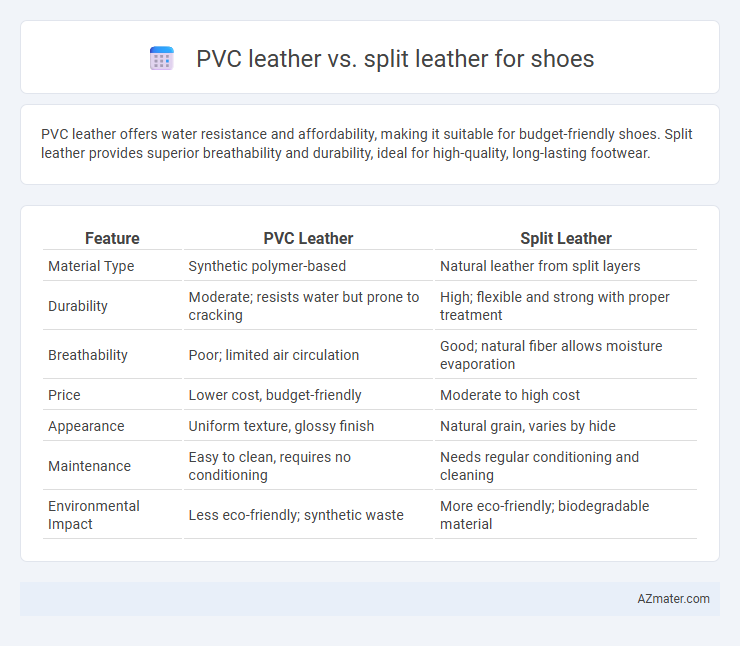PVC leather offers water resistance and affordability, making it suitable for budget-friendly shoes. Split leather provides superior breathability and durability, ideal for high-quality, long-lasting footwear.
Table of Comparison
| Feature | PVC Leather | Split Leather |
|---|---|---|
| Material Type | Synthetic polymer-based | Natural leather from split layers |
| Durability | Moderate; resists water but prone to cracking | High; flexible and strong with proper treatment |
| Breathability | Poor; limited air circulation | Good; natural fiber allows moisture evaporation |
| Price | Lower cost, budget-friendly | Moderate to high cost |
| Appearance | Uniform texture, glossy finish | Natural grain, varies by hide |
| Maintenance | Easy to clean, requires no conditioning | Needs regular conditioning and cleaning |
| Environmental Impact | Less eco-friendly; synthetic waste | More eco-friendly; biodegradable material |
Introduction to PVC Leather and Split Leather
PVC leather, a synthetic material made from polyvinyl chloride, offers water resistance, durability, and affordable production costs, making it a popular choice for shoe manufacturing. Split leather, derived from the fibrous lower layer of animal hides, provides a more natural texture but is less durable and water-resistant compared to full-grain leather. Both materials serve different purposes in footwear, with PVC leather favored for budget-friendly, easy-care shoes and split leather chosen for its authentic leather appearance at a lower price point.
Composition and Manufacturing Processes
PVC leather is a synthetic material made by combining polyvinyl chloride with plasticizers, resulting in a durable, water-resistant surface ideal for shoe uppers. Split leather originates from the fibrous lower layers of animal hides, undergoing processes like buffing and embossing to enhance texture and durability while maintaining breathability. Manufacturing PVC leather involves coating fabric substrates with polymer mixtures, whereas split leather requires precise splitting, tanning, and finishing techniques to produce a flexible and natural-feeling shoe material.
Aesthetic Differences: Look and Feel
PVC leather offers a smooth, glossy finish that mimics high-end leather but often appears more synthetic and uniform in texture, ideal for sleek, modern shoe designs. Split leather, derived from the fibrous lower layer of hides, has a rougher, matte surface that provides a natural, rugged aesthetic with visible grain patterns, enhancing rustic and casual footwear styles. The tactile experience of PVC leather is typically firmer and less breathable, while split leather feels softer and more porous, contributing to distinct visual and physical appeal in shoe manufacturing.
Durability and Wear Resistance
PVC leather offers high durability and excellent wear resistance due to its synthetic composition, making it suitable for shoes exposed to moisture and frequent use. Split leather, derived from the lower layers of animal hide, is less durable and more prone to abrasion compared to full-grain leather but provides moderate wear resistance at a lower cost. Shoes made with PVC leather tend to maintain their appearance longer under harsh conditions, while split leather requires careful maintenance to extend its lifespan.
Comfort and Breathability
PVC leather offers limited breathability and tends to trap heat and moisture, resulting in reduced comfort for prolonged wear. Split leather, derived from the fibrous part of the hide, provides better breathability and adaptability, allowing shoes to conform to the foot more effectively. Enhanced ventilation in split leather contributes to superior moisture management, making it a more comfortable choice for footwear.
Environmental Impact and Sustainability
PVC leather production involves synthetic polymers derived from non-renewable fossil fuels, releasing toxic chemicals and heavy metals that contribute to environmental pollution and landfill waste, making it less sustainable. Split leather, made from the lower layers of animal hides, utilizes by-products of the meat industry, reducing waste, but its tanning process often involves hazardous chemicals like chromium, impacting soil and water quality. Sustainable leather alternatives focus on minimizing chemical use and exploring biodegradable or recycled materials, whereas PVC leather's durability and low biodegradability pose significant sustainability challenges.
Cost Comparison: PVC vs Split Leather
PVC leather typically costs 30-50% less than split leather, making it a budget-friendly option for shoe manufacturing. Split leather, derived from the fibrous part of the hide, demands higher processing costs due to its durability and natural breathability. Manufacturers often choose PVC leather for affordable, water-resistant shoes, while split leather is preferred for premium, long-lasting footwear despite its higher price.
Maintenance and Care Requirements
PVC leather requires minimal maintenance due to its water-resistant and easy-to-clean surface, making it ideal for everyday shoe care with just a wipe of a damp cloth. Split leather demands more attention, including regular conditioning to prevent drying and cracking, as it lacks the protective top layer found in full-grain leather. Proper cleaning and occasional application of leather conditioners extend the lifespan and maintain the appearance of split leather shoes.
Common Applications in Shoe Industry
PVC leather is widely used in budget-friendly footwear due to its water resistance, durability, and ease of maintenance, making it ideal for casual shoes, sandals, and children's footwear. Split leather, derived from the lower layers of a hide, is commonly employed in mid-range shoe manufacturing, offering a balance between cost and natural leather appearance, often found in sneakers, loafers, and dress shoes. Both materials are chosen for specific performance and aesthetic qualities, with PVC leather favored for synthetic durability and split leather for enhanced breathability and comfort.
Choosing the Best Leather for Your Shoes
PVC leather offers water resistance and durability, making it a cost-effective choice for shoes that require easy maintenance and longevity. Split leather, derived from the lower layers of genuine leather, provides a more breathable and flexible option but may lack the strength of full-grain leather. Choose PVC leather for budget-friendly, weatherproof footwear and split leather for enhanced comfort and a natural feel in everyday shoe designs.

Infographic: PVC leather vs Split leather for Shoe
 azmater.com
azmater.com